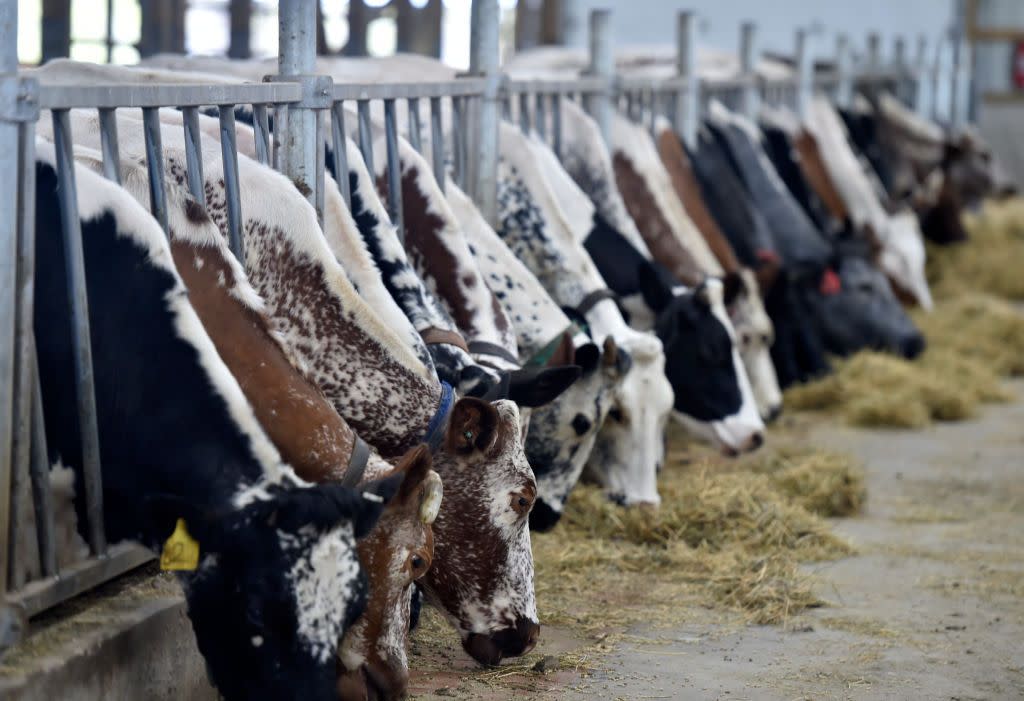It's The Worst Bird Flu Outbreak In American History, Here's How It's Impacting The Food Supply

"Hearst Magazines and Yahoo may earn commission or revenue on some items through these links."
A strain of bird flu that has primarily sickened wild birds is now affecting commercial poultry, livestock, and humans. The spread of H5N1, a highly pathogenic strain of avian flu, is rapidly evolving, prompting concern from public health officials.
An announcement by the U.S. Department of Agriculture last week confirmed outbreaks in dairy cows in four states, with another unconfirmed case in a fifth. This is the first time this strain has been identified in cattle. And on Monday, the Texas Department of State Health Services reported that an employee on one of the impacted dairy farms has contracted the virus—the second-ever case found in humans.
While the CDC reports that H5N1’s risk to public health remains low, much about the virus remains unknown. We're breaking down what officials currently know about the virus and how it will impact our health, eating habits, and grocery bills.
What Is H5N1?
Avian flu is a a type of viral disease that was first identified in 19th century Italy. Over 75 years later, scientists determined that it was a type A influenza virus. And just like the seasonal flu, there are several different strains of avian flu. Most strains of avian flu are categorized as low pathogenic avian influenza (LPAI) that cause little to no signs of disease. H5N1, however, is a type of highly pathogenic avian influenza (HPAI) that was first detected in 1996.
This particular strain of avian flu started to spread across Asia, Africa, the Middle East, and Europe in the early aughts, but did not reach North America until late 2021. Since it was first detected in the United States, nearly 10,000 cases have been identified in multiple species across all 50 states.
The CDC says that some wild birds can carry the virus without appearing ill, but can spread H5N1 through contact with other birds or through communal food and water sources. Waterbirds like geese, ducks, and swans are frequent carriers of the virus. Other common birds, like pigeons, crows, robins, sparrows, and cardinals, do not usually carry harmful strains of bird flu.

How Has H5N1 Affected Poultry & Livestock?
The H5N1 outbreak has impacted commercial poultry since early 2022, causing cases in over 82 million farmed birds alone. It’s been deemed the worst bird flu outbreak in American history—and the virus is showing no signs of stopping. Since the beginning of this year, nearly 2.5 million birds from commercial and backyard flocks have been affected.
Avian flu outbreaks in commercial poultry is known to occur sporadically in the United States and generally poses a low risk to public health. However, the situation escalated last week when USDA announced that the first ever cases of the H5N1 strain in cows were detected in four states.
As of this week, 11 herds of dairy cattle in Texas, Kansas, Michigan, and New Mexico have tested positive for bird flu. Another herd in Iowa is suspected to also be infected with H5N1 but is still awaiting confirmation from the USDA’s National Veterinary Services Laboratory.
While the virus may often be fatal for birds, the symptoms among cattle appear to be more mild. Officials in Texas report that affected cattle show signs of a loss of appetite, low-grade fevers, and a decrease in milk production. The milk produced by infected cows is thick, discolored, and contains viral H5N1 cells.
How Does H5N1 Affect Humans?
Up until this week, there was only one human case of H5N1. The patient, a Colorado state inmate who worked on a poultry farm as part of a pre-release employment program, contracted the virus in 2022. His only symptom was fatigue, which was treated with a antiviral medication for a successful recovery.
The second, newer case involved an employee on a Texas farm with confirmed cases of H5N1 among cattle. The infected person’s primary symptom was conjunctivitis. The commissioner of the Texas Department of Agriculture said that the exact source of the infection was unclear, but it was likely either an infected cow or dead wild birds that carried the virus.
Other human cases of H5N1 have been reported worldwide, like a man in Vietnam dying from the virus in March of this year. But it primarily impacts those who directly work with infected animals. There have been no identified cases of human-to-human transmission. According to the CDC, human infections are rare but have a fatality rate of over 50 percent.
The agency, however, maintains that the public health risk remains low. American poultry and dairy industries have strict health and safety standards that involve monitoring cases of bird flu, culling (or euthanizing) infected animals in certain cases, and processing dairy and egg products to minimize the spread of illness. NBC News reports that millions of chickens and turkeys have been killed to prevent the spread of H5N1, which has led to increased poultry prices to combat the smaller supply.
CDC officials note that while unconfirmed, there is a possibility that some human bird flu cases in Southeast Asia have been caused by improperly cooked poultry and poultry products. To minimize any potential risk, the agency advises that you steer clear of undercooked poultry and eggs (that means no runny yolks).
The Food and Drug Administration stresses that commercially processed milk is still safe for human consumption. Aside from preventing sick animals from contributing from the food supply, the dairy industry is also required to pasteurize their product to kill pathogens before they reach supermarket shelves.
The USDA also says that because of the limited scope of the H5N1 cases in cattle, along with higher production rates overall, the milk supply should remain unaffected. So consumers can rest assured that the cost of dairy shouldn't spike as a result of the infections.
The agency does, however, suggest that consumers steer clear from unpasteurized, or raw, milk. Federal health officials have maintained the position that raw milk comes with the inherent risk of harmful pathogens, which now can also include H5N1. In light of the new developments of bird flu in dairy cattle, the FDA is reminding shoppers to stick to pasteurized dairy.
You Might Also Like
